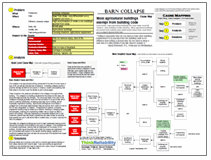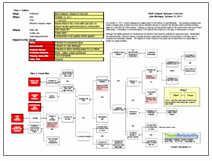Every winter there are pockets of agricultural building collapses in areas that have seen heavy snow and ice accumulation. The causes for these collapses can be examined in a Cause Map, or visual root cause analysis. First, we begin by capturing the basic information about the issue. In this case, there were three areas that suffered building collapses due to winter weather accumulation. This included New York State in 1999, Wisconsin in 2010, and England in 2010 and 2011. Important to note is that each of these areas experienced heavy snowfall during the periods of collapse and in each region, agricultural buildings were more likely than other types of buildings to have collapsed. It is also important to note that in each of these areas, agricultural buildings were not regulated to the same level as other buildings.
 To begin our root cause analysis, we begin with the impacts to the goals. The collapse of an agricultural building carries with it the risk of human injury or loss of life, as well as potential loss of livestock. A building collapse results in property damage as well as time spent on cleanup, repairs, and anything else that needs to be done to get the facility up and running again.
To begin our root cause analysis, we begin with the impacts to the goals. The collapse of an agricultural building carries with it the risk of human injury or loss of life, as well as potential loss of livestock. A building collapse results in property damage as well as time spent on cleanup, repairs, and anything else that needs to be done to get the facility up and running again.
To continue the analysis, we begin with the impacted goals and ask “why” questions. These impacts to the goals are all related to the collapse of an agricultural building. The collapse of a building results when the stress (in this case, the structural load) exceeds the strength. The structural loads in the case of the collapsed buildings generally result from accumulation of ice and snow, which may be unevenly distributed, increasing local load, due to drifting, and an improperly engineered building. Agricultural buildings are more likely to collapse due to structural loads because they are exempt from codes in most of the US and unregulated in England. If engineering is desired, a properly engineered building may be scaled up or altered, resulting in changing loads and strengths, meaning the engineering review may no longer be valid to protect the building. Although engineering is frequently skipped due to cost measures, experts say that proper engineering can save money by ensuring that supports are put in only where they’re needed (and, of course, reducing the risk of a collapse.)
Generally the collapsed buildings are found to have inadequate bracing, which reduces the strength of the building to the point of collapse. If the buildings are not properly engineered, bracing may be inadequate for the design of the building. Another issue frequently seen is that the trusses are engineered, but are not reviewed with respect to the overall building design, leading to an insufficient analysis that does not take into account all of the factors that impact building loads and strength.
Although states and countries could elect to consider agricultural buildings in their codes, farmers don’t need to wait. If you are building an agricultural building (or any building that may be exempt from code), ensure it’s adequately structurally engineered. It may save a life.
To view the Outline and Cause Map, please click “Download PDF” above. Or read more:



